
The increasingly digital, modern lifestyle that we all lead is inspiring homeowners to restyle their property to create larger living spaces that flow into entertainment areas outside and embrace more natural light.
Remodelling your home provides the opportunity to not only reassess floor plans, lighting and interior design but also the visual appeal from the street – a key factor when you decide to sell and climb further up the property ladder.
A renovated home styled for the needs of the early 21st century should have a contemporary appearance.
Few factors influence this more than your roofing selection. Some 30 per cent of your façade can be made up of the roof.
The humble corrugated tin roof that served Australia so well for 200 years is being replaced by more durable, high-tech alternatives that not only look great but provide greater insulation.
All roofs can be assess for their heat absorption and reflection using a BASIX rating system, which can guide you on the most appropriate materials for your property. The glaze on the tiles, as well as their degree of smoothness, have an influence on their environmental impact.
Here are five roof alternatives to consider:
Terracotta – It’s a natural material with incredible durability. It doesn’t collect condensation and mould and the colour won’t fade. Modern terracotta tiles come in a variety of shapes and finishes, including metallic. If you’re looking to create a Mediterranean style home, there isn’t a better choice.
Concrete – This isn’t the first material you might consider when thinking about roofing tiles. Yet, it is an incredibly strong and durable option that comes in a wide variety of styles and colours. You might consider asking your supplier or architect for ideas to create a patterned roof, using various shades of coloured concrete. It is also possible to integrate them seamlessly with a solar energy system. That means you avoid those ugly black panels sitting on top of your house.
High-tech composites – Tile manufacturers have used research and innovation developed in other industries, such as aerospace and automotive, to develop lightweight tiles suitable for low-pitch roof lines. Composite tiles are suitable for pitch lines of just 10 degrees. This gives you the opportunity to create a modern home with a striking roof that can appear almost flat to the naked eye. Composite materials have a UV coating to resist fading and saltwater damage, which makes them perfect for beach homes. They’re also designed to be strong enough for major storm events, including hail.
Steel – The most popular steel alternative is from Colorbond. It’s still a winner for many – a perfect cultural fit in regional areas and offering striking effects for the most modern of buildings. Colorbond roofing materials come in 22 colours and are BASIX rated. Essentially, the lighter the colour, the less heat absorption. The manufacturer states its products have been tested in Australian conditions for durability and corrosion for 50 years. Five colours in the steel range qualify as solar reflective roofing under the Green Star Communities tool. The company also boasts its development of Thermatech® technology, which reflects the sun’s heat. This insulates the interior of the home and will reduce use and cost of air-conditioning.
Slate – This is a wonderful, opulent selection of roofing material that is often overlooked. There’s no getting away from the fact that original slate looks absolutely fabulous, especially on heritage homes. Various styles of slate offer various patterns, textures and colours. Derived from sedimentary rock of clay and volcanic ash, slate is millions of years old. It is incredibly durable and will last a century or longer. Be aware, slate is much heavier than other materials and your roof will need to be engineered to take the extra weight.
